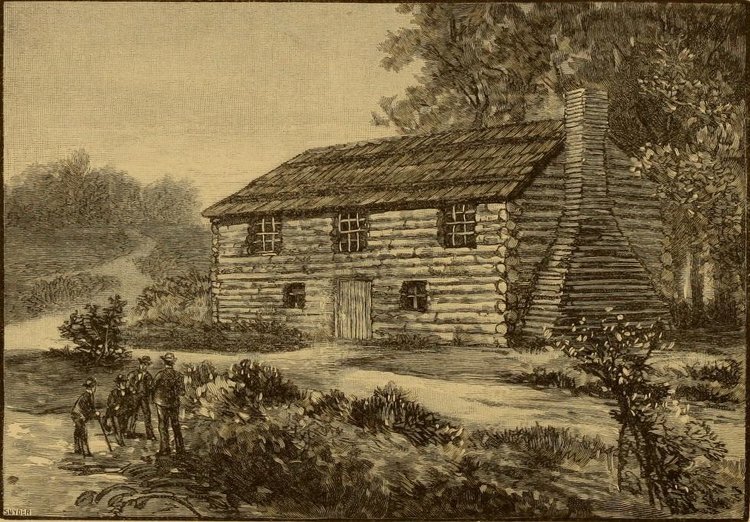Receive our blog posts in your email by filling out the form at the bottom of this page.
“Preach the gospel, die, and be forgotten.” — Attributed to Count Nicholas Ludwig von Zinzendorf (18th century Moravian minister)
There are some figures in church history about whom we know very little, even though they accomplished very much. John Martin is one such person. It is believed that he was born in Virginia, in the early 18th century. He first appears in the records of the Hanover Presbytery for March 1756.
Mr. John Martin offered himself upon Tryals for the gospel Ministry, and delivered a Discourse upon Eph. 2.1 which was sustain’d as a Part of Tryal; & he was also examined as to religious Experiences, & the reasons of his designing the ministry; which was also sustain’d. He was likewise examined in the Latin and Greek languages, and briefly in Logick, ontology, Ethics, natural Philosophy, Rhetoric, geography and Astronomy; in all which his Answers in general were very satisfactory. And the Presbytery appoint him to prepare a Sermon on I Cor. 1.22-23, & an Exegesis [in Latin] on this Question, Num Revelatio Supernaturalis sit Necessarias? to be delivered at our next Committee.
At the following meeting he preached that sermon and presented his exegesis after which “The Committee proceeded to examine him upon ye Hebrew, and in sundry extempore Questions upon ye Doctrines of religions, and some Cases of Conscience.” Then he was required to deliver a sermon on Galatians 2:20 at the next meeting of presbytery and to give a lecture on Isaiah 61:1-3. Having done this successfully, he was then required to compose a sermon at the next presbytery meeting on I John 5:10, whereupon
The Presbytery farther examin’d Mr. Martin in sundry extempore Questions upon various Branches of Learning, and Divinity, and reheard his religious Experiences; and upon a review of ye sundry Trials he has passed thro’; they judge him qualified to preach ye Gospel; and he having declar’d his Assent to, and Approbation of ye Westminster Confession of Faith, Catechisms, and Directory…ye Presbytery do license and authorize him to preach as a Candidate for ye ministry of ye Gospel…and appoint ye moderator to give him some Solemn Instructions and Admonitions, with regard to ye Discharge of his office. [source: Ernest T. Thompson, Presbyterians in the South, Vol. 1 (1963), p. 69]
Martin was licensed to preach the gospel on August 25, 1756, and received a call to serve in Albemarle County, Virginia in April 1758. He was ordained to the ministry in June 1758 (various sources record the date as June 5, 7, or 9, 1758) at which time Samuel Davies preached the ordination sermon in Hanover, Virginia: The Office of a Bishop a Good Work. Thus, Martin was the first man ordained as a Presbyterian minister in Virginia. However, Martin declined the call to Albemarle, and instead was commissioned by an organization founded by Davies known as the Society For Managing the Mission and School Society For the Propagation of the Gospel to serve as a missionary to the Overhill Cherokee Indians in Tennessee. Later that year, he traveled as far as the Little Tennessee River and preached to the Cherokees there; however, without any significant success to report. However, in so doing, Martin became the first Protestant minister to preach the Gospel in the bounds of the state of Tennessee. His ministry there was supplemented by William Richardson (whose missionary journal still exists today in the archives of the New York Public Library). The efforts of both men were thwarted by language and culture challenges, but especially the commencement of hostilities in the French and Indian War. Also, when Davies left Virginia and took up his post as President of the College of New Jersey at Princeton in 1759, the missionary society that he had founded in Virginia fizzled out as well. Both Martin and Richardson departed from Tennessee and went on to settle in South Carolina. It is not known precisely where he lived, when he died or where he was buried. (See Richard Webster, A History of the Presbyterian Church in America From Its Origin Until the Year 1760 (1858), p. 674; George Howe, History of the Presbyterian Church in South Carolina, Vol. 1 (1870), p. 267; Alfred Nevin, Encyclopedia of the Presbyterian Church in the United States of America (1884), p. 472; Samuel C. Williams, An Account of the Presbyterian Mission to the Cherokees, 1757-1759, Tennessee Historical Magazine (Jan. 1931); William W. Crouch, Missionary Activities Among the Cherokee Indians, 1757-1838 (1932); and A. Mark Conard, The Cherokee Mission of Virginia Presbyterians, Journal of Presbyterian History (Spring 1980).)
From the little that we know about Martin, we can ascertain that he was well-educated for the ministry, had a heart for missions, and was willing forgo a stable pastoral call in order to go where he believed he was most needed to preach the gospel. His pastoral career is a but a blip on the historical radar, but as the first Presbyterian minister ordained in Virginia, and the first to preach the gospel in Tennessee, he is worthy of remembrance.






